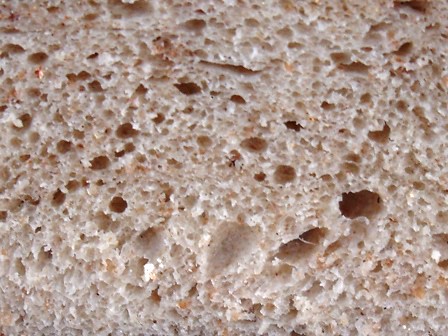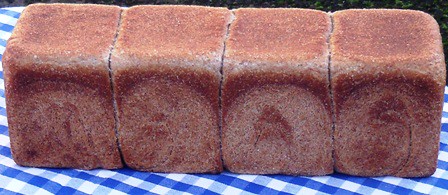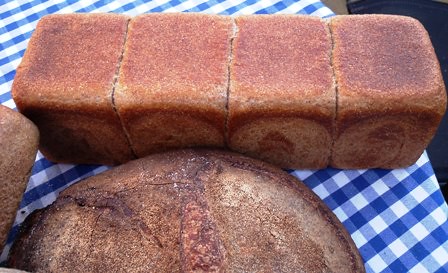“Rossisky” using the Three Stage Auerman Process; Pain au Levain using Rye Sour and Wheat Leavens; Panned “Wholewheat-style” Loaves with mixed leavens.



Refreshment Régimes:
- 1. Rye Sourdough
Refreshment One. Saturday 16:00
Material | Weight [grams] |
Rye Sour from Stock | 90 |
Bacheldre Organic Dark Rye Flour | 60 |
Water | 100 |
TOTAL | 250 |
Refreshment Two. Sunday 07:30
Material | Weight [grams] |
Refreshment One | 250 |
Bacheldre Organic Dark Rye Flour | 300 |
Water | 500 |
TOTAL | 1050 |
Refreshment Three. Sunday 15:00
Material | Weight [grams] |
Refreshment Two | 1050 |
Bacheldre Organic Dark Rye Flour | 130 |
Water | 215 |
TOTAL | 1395 |
- 2. Wheat Levain
Refreshment One. Saturday 16:00
Material | Weight [grams] |
Wheat Levain from Stock | 20 |
Marriage’s Organic Strong White Flour | 100 |
Water | 60 |
TOTAL | 180 |
Refreshment Two. Sunday 07:30
Material | Weight [grams] |
Refreshment One | 180 |
Marriage’s Organic Strong White Flour | 200 |
Water | 120 |
TOTAL | 500 |
Refreshment Three. Sunday 15:00
Material | Weight [grams] |
Refreshment Two | 500 |
Marriage’s Organic Strong White Flour | 315 |
Water | 189 |
TOTAL | 1004 |
************************************************************************************************
- 1. “Rossisky” using the Three Stage Auerman Process
See Refreshment Régime above for sour building. The “Scald” was made at the same time as the 3rd refreshment. The “Sponge” was made 21:00 Sunday night. The final paste was made 09:00 Monday morning.
Material/Stage | Formula [% of flour] | Recipe [grams] |
1. a] Built Sour [see above] | | |
Bacheldre Organic Dark Rye Flour | 24 | 240 |
Water | 40 | 400 |
TOTAL | 64 | 640 |
| | |
1. b] “Scald” | | |
Crystal Barley Malt Powder | 6 | 60 |
Bacheldre Organic Dark Rye Flour | 20 | 200 |
Boiling Water | 39 | 390 |
TOTAL | 65 | 650 |
| | |
2. “Sponge” | | |
Built Sourdough [from 1. a]] | 64 | 640 |
“Scald” [from 1. b]] | 65 | 650 |
TOTAL | 129 | 1290 |
| | |
3. Final Paste | | |
“Sponge” [from 2.] | 129 | 1290 |
Bacheldre Organic Dark Rye Flour | 50 | 500 |
Salt | 1.5 | 15 |
Water | 6 | 60 |
TOTAL | 186.5 | 1865 |
Overall % pre-fermented flour | 24 + 26 =50 | - |
Overall % hydration | 85 | - |
FACTOR | 10 | - |
Method:
- Build the sour as above. Make the “scald” at the same time as the final refreshment of the sour, by pouring boiling water onto the flours and mixing. Allow to cool to room temperature, covered.
- Make the “Sponge”, by combining the Built Sour with the “Scald”. Leave to ferment, covered, for a further 12 hours [this proved to be too long; recommended time is 4 hours!]
- Add the remaining ingredients to the “Sponge” to make the final paste. Target temperature is 29 - 30°C.
- Bulk Ferment for one hour.
- Scale and divide: I made one loaf in a pan @ 1kg, and one shaped round and proved in a banneton using the remaining paste.
- Bake on the “dead” wood-fired oven.
- Cool on wires, and set aside wrapped in linen cloth for 24 hours, before slicing.

- 2. Pain au Levain using Rye Sour and Wheat Leavens
See Refreshment Régime above for the rye sour and wheat levain building.
Material/Stage | Formula [% of flour] | Recipe [grams] |
1. a] Wheat Leaven | | |
Marriage’s Organic Strong White Flour | 15 | 300 |
Water | 9 | 180 |
TOTAL | 24 | 480 |
| | |
1. b] Rye Sourdough | | |
Bacheldre Organic Dark Rye Flour | 9 | 180 |
Water | 15 | 300 |
TOTAL | 24 | 480 |
| | |
2. Final Dough | | |
Wheat Leaven [from 1. a] | 24 | 480 |
Rye Sourdough [from 1. b] | 24 | 480 |
Carrs Special CC Flour | 60 | 1200 |
Allinson Strong Wholemeal | 16 | 320 |
Salt | 1.8 | 36 |
Water | 44 | 880 |
TOTAL | 169.8 | 3396 |
% overall pre-fermented flour | 24 | - |
% overall hydration | 68 | - |
FACTOR | 20 | - |
Method:
- Build the sour and leaven as above.
- Autolyse flours, water and rye sourdough for the final dough for 1 hour.
- Combine all materials for the final dough and mix to develop.
- Bulk proof 1½ hours
- Retard overnight, covered.
- Scale and divide: one @ 1500g, one @ 700g and one just short of 1200g. Mould round and proof in prepared bannetons.
- Final proof: 3 hours
- Bake: Decant each loaf onto the peel, score an “S” shape onto the top, and set in the wood-fired oven to bake.
- Cool on wires.





- 3. Panned “Wholewheat-style” Loaves with mixed leavens.
These loaves are a request from a new-found customer who lives in the next village to us, and has been buying bread from the Village Bakery, Melmerby, where I used to work, for many years.
It’s as “plain”, as I go when working at home, and is largely wholewheat-based, which was the main tenor of the request. It’s also made in pans, to allow for breaking into small and easy quantities for freezing down.
The refreshment régimes for both the pre-ferments are shown above. The soaker was prepared at the same time as the final refreshments took place.
Material/Stage | Formula [% of flour] | Recipe [grams] |
1. a] Wheat Levain | | |
Marriage’s Organic Strong White Flour | 25 | 300 |
Water | 12 | 144 |
TOTAL | 37 | 444 |
| | |
1. b] Rye Sourdough | | |
Bacheldre Organic Dark Rye Flour | 6 | 72 |
Water | 10 | 120 |
TOTAL | 16 | 192 |
| | |
2. Soaker | | |
Gilchesters Organic Farmhouse Flour | 9 | 108 |
Salt | 10.8 | 129.6 |
Water | 0.2 | 2.4 |
TOTAL | 20 | 240 |
| | |
3. Final Dough | | |
Wheat Levain [from 1. a] | 37 | 444 |
Rye Sourdough [from 1. b] | 16 | 192 |
Soaker [from 2.] | 20 | 240 |
Allinson Strong Wholemeal | 60 | 720 |
Salt | 1.5 | 18 |
Organic Lightly Salted Butter | 1.5 | 18 |
Water | 37 | 444 |
TOTAL | 173 | 2076 |
% overall pre-fermented flour | 31 | - |
% overall hydration | 69.8 | - |
FACTOR | 12 | - |
Method:
- Build the leaven and sour as above, and prepare a cold soaker [2], at the same time as the final refreshment stage for each pre-ferment.
- Combine the rye sourdough, soaker, flour and water for the final dough for 1 hour autolyse.
- Add the remaining ingredients and mix to develop a strong dough.
- Bulk proof 1½ hours.
- Retard overnight in the chiller, covered.
- Scale and divide: 4 pieces @ 390g for the Pullman Pan, and one piece @ 516g for the smaller loaf. Mould round and rest, covered for 15 minutes. Shape and pan.
- Final proof for 3 hours.
- Bake in the wood-fired oven.
- De-pan and cool on wires.



Comments.
The Russian Rye paste was too stiff, and therefore slow to prove; always a worry from my experience, producing a tasty, but dense loaf of reduced quality. I fear the “zavarka” was too stiff, as a result of exuberance on my part boiling the water, resulting in excessive starch gelatinisation. Result? A very tasty dark loaf, but very dense!
I badly need more wood to fire the oven. It was pleasing to bake these 3 varieties, but I now acknowledge I need a regular supply of tinder dry, soft wood; cut small. The search continues…
Both the other doughs proved well and made good bread. Today was a lovely sunny day here in Northumberland; however, there was a really sharp frost overnight, so it was a challenge to keep the dough warm enough to enable active final ferment, given 2 of the doughs had overnight retard. The wholemeal looked particularly good. Oven spring in both was fine, and the crumb of the Pain au Levain with the 2 pre-ferments looks great. The crust? This is where the wood-fired oven is really coming into its own with wonderful radiated heat from the arched roof of firebrick.
I managed to sell 4 of the 7 loaves I made today and net £10 proceeds. My business adviser came to see me, and he left with a loaf he was happy to purchase, full of positivity about my progress, and other ideas I have too: a “pre-order Pizza Takeaway” service one night a week? Seems like a winner to me!
This is arriving on a pallet by courier tomorrow, and I can’t wait! An old 20 quart Hobart planetary mixer, but in excellent working order. So, making up to 10kg of dough at a time should be really easy moving forward.
http://www.flickr.com/photos/24731237@N03/6324106618/in/photostream


Happy Baking Everybody!
Andy